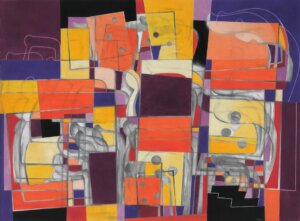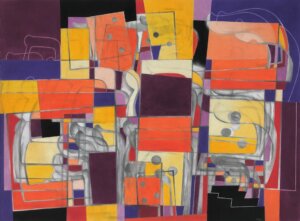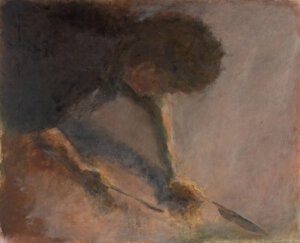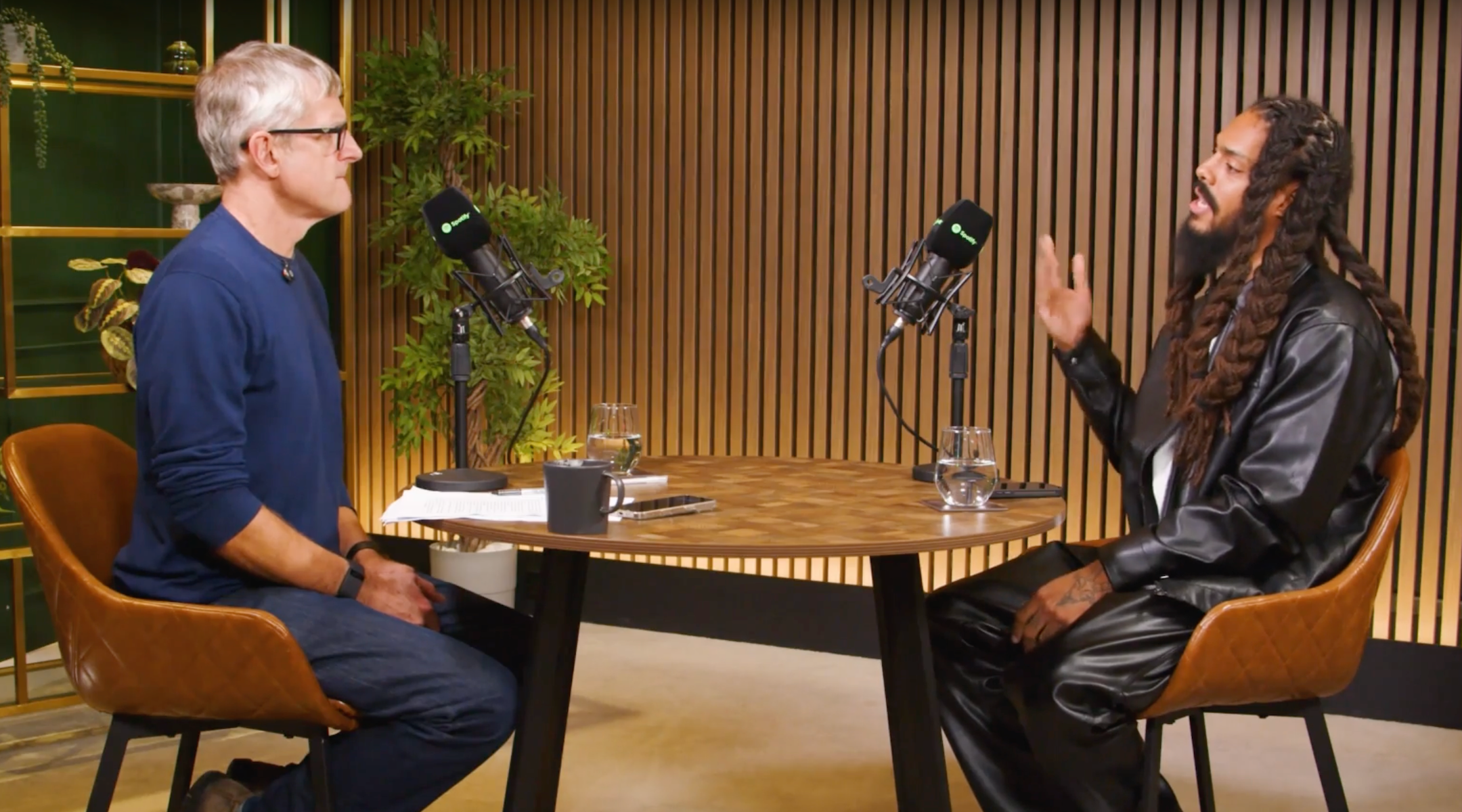Uncategorized
One was born Catholic, another was a West Virginia Protestant — now they’re all making Jewish art

In artist Yona Verwer’s “Immersion VIII,” a nude woman in a fetal position floats in a swirl of water. The image is at once ethereal and surreal, not unlike Verwer’s first mikveh experience, a purification ritual, and central to conversion, the transition from non-Jew to Jew.
“It is the joy of weightlessness and the feeling of being spiritually elevated,” said Verwer, the co-founder of the Jewish Art Salon, who was born Catholic in the Netherlands and converted to Judaism in 1995.
“Five years after my conversion I started including Jewish subject matter in my paintings, that is to say contemporary visual interpretations of ancient texts,” she added. “I also examine contemporary themes like identity, ecology, antisemitism and more through a Jewish lens.”
“Immersion VIII” is one of 17 works in an original and perhaps unprecedented exhibit, “Children of Ruth: Artists Choosing Judaism,” currently running at the Heller Museum at Hebrew Union College. The thought provoking display features the paintings, drawings, collages, found objects and sculptures created by artists who have discovered a home through conversion. Some of the pieces are abstract, others representational and still others combinations thereof or not readily definable at all. None of it is kitschy, reductive or derivative.
Hailing from across the globe and representing an array of ethnic, social and religious backgrounds, all the artists have forged work informed by various aspects of their conversions. There is commentary on biblical texts, illustrations of Jewish rituals and others that merge imagery from the artists’ early backgrounds with representations of and metaphors for Judaism and Jewish life. In more than a few pieces, the Golem — the ultimate outlier who is nevertheless the mystical protector of the Jewish people — makes an appearance.
“I wanted to be Jewish from the time I was 11 despite knowing almost nothing about Judaism, and not meeting a Jew until I was 19,” Verwer said. “It felt irrational, but later, the Lubavitcher Rebbe’s words resonated — that sincere converts to Judaism possess an inherent Jewish soul, even prior to their formal conversion. In other words, converts are not outsiders but returning kin.”

The reasons for the artists’ conversions run the gamut. Kate Hendrickson grew up in West Virginia, the child of Protestants. Her mother was a choral director and organist and her father sang in the choir in both Presbyterian and Methodist churches. Neither parent was doctrinaire in their beliefs.
“I couldn’t buy Christian dogma at all or the idea that Jesus was the savior,” she said. “I married a Sephardic Jew who was raised in Morocco. His family embraced me, especially his mother. I used to follow her around in the kitchen, studying her recipes. When she died at 97, I felt ungrounded and wanted to explore Judaism. The rabbi suggested I do independent study and I attended services. Still, I wondered when I would become Jewish. A friend, another convert, said that she just woke up one morning and knew she was a Jew. The rabbi said, ‘Anytime will be a good time for you.’ I love Judaism because it feels so open-ended. It feels like home.”
In “Concealed Faith,” Hendrickson’s first series of post-conversion drawings, Hebrew letters, which are an integral part of her Cubist designs, are concealed. In the series that followed, “Faith Revealed,” Hebrew letters are even more central to the aesthetic and more clearly visible, at least to the attuned eye. Further, Hebrew letters inform the way she creates her art.
Hendrickson translates the title of each work into Hebrew, then creates cut-outs of each Hebrew letter.
“I rub graphite over the cut-outs and then randomly drop them onto my paper and rub them across the drawing, their edges and curves serving as structures for the composition.”
A number of the artists said Judaism appealed to them because of its openness to interpretation and reinterpretation, adding how much they valued the chance to express unexpected or even controversial viewpoints in their imagery.
Artist Mike Cockrill, a social justice advocate who has studied Torah for two decades, puts forth a feminist vision in his piece, “Excavation,” which reinvents Judaism’s patriarchal tradition.
Here, two women, posed in a manner that hints at Egyptian forms, are engaged in a metaphorical excavation. One holds a book, while the other, paintbrush in hand “is ready to repaint, rewrite, the traditional history from which she may have been excluded or been misrepresented,” he said. “Patriarchy lies at the women’s feet in the form of a blindfolded and disembodied head.”
Before Cockrill’s formal conversion, many of his paintings embodied an Americana vernacular, at times a tad mocking. During his Torah study period, his paintings made a radical shift, embracing an aesthetic that addressed the human condition, “the existential man, the meaning of life, which is funny but also dark,” he said.
“The rabbi who converted me was concerned that conversion would affect my painting in a negative way, that I would be doing Jewish kitsch,” he recalled. “I want to embrace my Judaism without pandering or being obvious and corny.”
Other artists combine ethnic or cultural elements of their pre- and post- conversion lives. Carol Man forged a design that couples Hebrew and Chinese calligraphy. Vicky Vogl, the daughter of an Ecuadorian mother and Czechoslovakian Jewish father, created an exquisitely detailed puppet theater depicting a Golem in a setting that also embraces a Latino aesthetic.
“The clock has Hebrew letters and the hands move counterclockwise,” she said. “The colors and craftsmanship are Ecuadorian and European.”

The genesis of this exhibit was almost a fluke. Curator Nancy Mantell recalled that at an earlier exhibit about the Torah, one artist revealed that she was Norwegian, had converted to Judaism, and was working on a textile project based on Torah portions. “We were so impressed by her commitment to her Jewish learning it made us start thinking, ‘Wow, are there other artists who have joined the Jewish people and have Jewish themes in their art?’” Mantell recorded.
She and Susan Picker, the assistant curator, put out a request for submissions. Throughout the process of choosing submissions, Picker says she was taken with the artists’ “love of Judaism and a sense of return to their deepest souls, with a love of grappling with Jewish texts.”
Alan Hobscheid, who grew up in Chicago, the son of a lapsed Catholic father and Japanese mother, became exposed to Judaism in college through friends and later married a Jewish woman. To some degree his conversion was expedient and, simultaneously, an expression of osmosis, he admitted. But, also, he stressed he always had a curiosity about Judaism.
As a convert he was especially drawn to the way that “Judaism doesn’t sugar coat or obfuscate God’s relationship to man,” he said. “The doubt and skepticism spoke to me. So does the duality in many of the customs, such as the cleaning up and preparation for Passover. It’s very serious, but there are fun elements.”
Still, in his oil painting, “Bedikat Chametz,” the literal darkness of that pre-Pesach ritual especially spoke to him. The painting portrays a man on the floor in a darkened space, scrounging around, searching for the last bits of leavened bread in order to dispose of it.
“It’s not despairing at all,” said Hobscheid. “There’s a beauty in it and conversion is a similar process. You must leave something behind in order to move on to something else.”
“Children of Ruth” runs through Feb. 26 at the Heller Museum at Hebrew Union College.
The post One was born Catholic, another was a West Virginia Protestant — now they’re all making Jewish art appeared first on The Forward.
Uncategorized
Hamas Expands Terror Operations Across Europe Amid Gaza War, Exploiting Criminal Networks and Weapons Caches

Palestinian Hamas terrorists stand guard on the day of the handover of hostages held in Gaza since the deadly Oct. 7, 2023, attack, as part of a ceasefire and a hostages-prisoners swap deal between Hamas and Israel, in Rafah in the southern Gaza Strip, Feb. 22, 2025. Photo: REUTERS/Hatem Khaled
Hamas has expanded its terrorist operations beyond the Middle East, exploiting a long-established network of weapons caches, criminal alliances, and covert infrastructure that has been quietly built across Europe for years, according to a new report.
Earlier this month, West Point’s Combating Terrorism Center released a study detailing how Hamas leaders in Lebanon have directed operatives to establish “foreign operator” cells across Europe, collaborating with organized crime networks to acquire weapons and target Jewish communities abroad.
“Hamas has never carried out a successful terrorist attack outside of Israel, the West Bank, or Gaza — but not for lack of plotting,” Matthew Levitt, a senior fellow and counterterrorism expert at the Washington Institute for Near East Policy, wrote in the report.
“European and Israeli officials fear that Hamas has taken the decision to go global and carry out plots abroad, marking a significant departure from the group’s prior modus operandi,” he continued.
For example, the study cited a failed Hamas plot in which an alleged operative in Germany traveled to Lebanon to “receive orders from the Qassam Brigades [Hamas’s military wing] to set up an arms depot for Hamas in Bulgaria,” part of a broader, multi-year effort to cache weapons across Europe.
However, German authorities foiled the plot, detaining four Hamas members in late 2023 on suspicion of planning attacks.
Earlier this year, the four suspects went on trial in Berlin in what prosecutors described as Germany’s first-ever case against members of the Palestinian terrorist group.
According to German officials, the weapons “were intended to expand Hamas’s activities in Europe.”
During the investigation, German authorities also found evidence on a defendant’s USB device showing that the Hamas operatives were planning attacks on specific sites in Germany, including the Israeli embassy in Berlin.
Similar weapons depots were established in Denmark, Poland, and other European countries, with Hamas members repeatedly trying to retrieve them to support their operations and plan potential attacks.
The newly released report identified Hamas’s operational headquarters in Lebanon as the command center for its activities abroad, with senior leaders directly managing plots across Europe.
“Even before Oct. 7, Hamas leaders periodically threatened to carry out attacks abroad,” Levitt explained in his report, referring to the Iran-backed Islamist group’s invasion of and massacre across southern Israel in 2023.
“The increased Hamas terrorist activity abroad correlates to the establishment of a Hamas operational component in Lebanon driven by senior Hamas leaders,” he said, noting that such network “developed over time, as senior Hamas leaders left Turkey and Qatar and later made their way to Lebanon.”
The study also reported that Hamas operatives established alliances with European organized crime networks to secure weapons and logistical support for their operations.
For example, another major plot was foiled earlier this year, when a member of the Danish, banned Loyal to Familia (LtF) gang was indicted for purchasing Chinese drones intended for attacks in Denmark or Sweden. Local authorities later revealed that the gang had been working with Hamas, which has ruled Gaza for nearly two decades.
This month, German authorities foiled another planned terrorist attack, arresting three suspects on the eve of Yom Kippur who were preparing to target Jewish institutions.
According to the report, analysts remain uncertain whether these plots signal a permanent strategic shift or reflect a short-term tactical adjustment in response to the Gaza war.
“It remains unclear how decisions about such operations are made and if this includes input and approval from a broad range of Hamas leadership or just a select few,” Levitt said.
Given the loss of Hamas’s leadership and the resulting decentralized decision-making, the report noted that external operations may now be possible where they were previously constrained by internal disagreements.
“With Hamas operational capabilities in Gaza severely degraded, and the group under pressure from both Israeli and Palestinian Authority security forces in the West Bank, the group’s military commanders may find that acts of international terrorism carried out by small cells … may be a more central component of Hamas’s attack strategy,” Levitt concluded.
Uncategorized
British Airways breaks ties with Louis Theroux after interview with ‘Death to the IDF’ artist Bob Vylan

(JTA) — British Airways has dropped its sponsorship of documentarian Louis Theroux’s podcast following an interview with British punk musician Bobby Vylan where the artist defended his chants of “death, death to the IDF” at the Glastonbury music festival.
Following the band’s Glastonbury performance in June, the two members of Bob Vylan had their U.S. visas revoked by the State Department ahead of a planned tour this month. The BBC also said the livestream of the performance broke its guidelines because Bob Vylan’s chants could “fairly be characterised as antisemitic.”
Bob Vylan’s frontman, whose real name is Pascal Robinson-Foster, Theroux that he did not regret the chants during the interview.
“If I was to go on Glastonbury again tomorrow? Yeah, I would do it again. I’m not regretful of it,” said Vylan. “I’d do it again tomorrow, twice on Sundays. I’m not regretful of it at all. Like, the subsequent backlash that I’ve faced is minimal. It’s minimal compared to what people in Palestine are going through.”
Robinson-Foster also criticized a report by the Community Security Trust, British Jewry’s antisemitism watchdog, that found antisemitic incidents had spiked the day after Bob Vylan’s set, telling Theroux that it was unclear what the group was “counting as antisemitic.”
“I don’t think I have created an unsafe atmosphere for the Jewish community,” said Robinson-Foster. “If there were large numbers of people being like, going out and ‘Bob Vylan made me do this,’ then maybe I might go, woof, I’ve had a negative impact here. Again, in that report, what definition are they going by? We don’t know that.”
During the interview, Robinson-Foster also said that the “focus” should not have been placed on the “death to the IDF” chant, but rather “on the conditions that allow for that chant to exist.”
“Ultimately, the fight is against white supremacy, right?,” said Robinson-Foster. “That is what the fight is against. And I think white supremacy is displayed so vividly in Zionists.”
In response, Theroux replied, “They say we’re not white, we’re Jewish, right?”
Later, Theroux appeared to agree with Robinson-Foster’s assertion that the “Zionist movement and the war crimes being committed by Israel” should be viewed through the “lens of white supremacy.”
“I think I’d add to that, there’s an even more macro lens which you can put on it, which is that Jewish identity in the Jewish community, as expressed in Israel, has become almost like an acceptable quote, unquote, way of understanding ethno-nationalism,” said Theroux, later adding that “this sense of post-Holocaust Jewish exceptionalism or Zionist exceptionalism, has become a role model on the national stage for what these white identitarians would like to do in their own countries.”
Following the interview, Theroux drew criticism for failing to challenge Robinson-Foster’s defense of his chants during the interview.
“Louis Theroux has every right to interview whoever he wants, but with that right comes responsibility,” Jewish film producer Leo Pearlman told the British outlet Jewish News. “When you give a microphone to someone who proudly repeats a genocidal chant that played a part in inspiring attacks on Jews across Britain, you’re not probing hate, you’re amplifying it.”
Dave Rich, the head of policy at the Community Service Trust, wrote in a blog post that he had been distressed that Theroux did not note that Robinson-Foster had publicly undercut the idea that his chant of “death to the IDF” was not meant as a call to voice when he commented at another concert, “We are for an armed resistance. We wanna make that explicitly f–king clear.” Rich also criticized the decision to release the interview even after the attack on a Manchester, England, synagogue in which two people were killed on Yom Kippur.
“Theroux’s podcast was recorded before the Manchester attack, which he acknowledges in the introduction,” Rich wrote. “But they still went ahead and published it anyway, as if the death of two Jews due to an Israel-hating jihadist doesn’t change the context of an interview with someone who became famous for calling for death for Israelis.”
After the interview aired on Spotify last Friday, British Airways issued a statement to announce it had dropped its sponsorship of Theroux’s show.
“Our sponsorship of the series has now been paused and the advert has been removed,” the airline wrote in a statement shared with the British outlet Jewish News. “We’re grateful that this was brought to our attention, as the content clearly breaches our sponsorship policy in relation to politically sensitive or controversial subject matters.”
The episode follows the release, in April, of a documentary by Theroux titled “The Settlers” that served a searing portrayal of the far-right Israeli settler movement in the West Bank.
The post British Airways breaks ties with Louis Theroux after interview with ‘Death to the IDF’ artist Bob Vylan appeared first on The Forward.
Uncategorized
Prominent Orthodox politician swaps endorsement of Sliwa for Cuomo as NYC mayoral election nears
(JTA) — Curtis Sliwa has long pointed to Dov Hikind, a former New York state assemblyman who represented Jewish neighborhoods in Brooklyn for more than three decades, as one of strongest allies within the New York Jewish community.
Last month, in an interview with the Jewish Telegraphic Agency, Sliwa named Hikind, who also founded the nonprofit Americans Against Antisemitism, as a key Jewish figure in his circle. The pair also canvassed together during Rosh Hashanah.
“Without a doubt, the man that I’ve been through so many struggles over the years is Dov Hikind,” said Sliwa. “He knows everyone, and he is completely in support of me because he knows, whenever Jews have been in need, he says, ‘Curtis was always there.’”
But on Sunday, as early voting started in the election, Hikind dropped his support for Sliwa. Instead, he urged New Yorkers to vote for former Gov. Andrew Cuomo in a last-ditch effort to halt frontrunner Zohran Mamdani’s march to City Hall.
“As difficult as it is for me to post this video, I must face the reality as I see it,” Hikind said in a message posted to social media. “I endorsed Curtis Sliwa and while I never thought I’d say this, I am now asking that you vote for Andrew Cuomo. Why? Because if Mamdani wins, the very future of New York City is at stake.”
He added, “You don’t have to love Cuomo. I’ve been clear about how I feel about him. This election though isn’t about who we like. It’s about saving New York City from Mamdani.”
Hikind’s flip-flop comes as Jewish advocates increasingly urge voters to back Cuomo as a way to consolidate opposition to Mamdani, a democratic socialist who is staunchly critical of Israel. With Mamdani posting a double-digit lead over Cuomo in polls, and Sliwa is tailing third in the race, some Jewish voices are intensifying efforts to persuade Sliwa to drop out and back Cuomo. That includes in Hikind’s region of Brooklyn, where the exit last month of Mayor Eric Adams from the race caused some Jewish leaders who had not committed to a candidate to back Cuomo.
Hikind has indeed long criticized Cuomo for his handling of the COVID-19 pandemic and the sexual harassment allegations against him in 2021 that led to his resignation.
“I believe that the person that is best for the people of New York is Curtis Sliwa,” said Hikind during a Fox News interview posted by Sliwa on Instagram earlier this month. “We have Cuomo, who was governor of the state of New York, and quit. He decided to quit because of things that he was involved in, the inappropriate behavior with so many women, and let’s not forget, Cuomo is responsible for 1000s and 1000s of senior citizens being sent to nursing homes during COVID.”
In 2020, Hikind published a book trolling Cuomo’s decisions during the pandemic titled “Lessons in ‘Leadership,’” that included a foreword lambasting “King Covidius Cuomo” followed by 100 pages of blank white paper.
Now, he said in his new post, he had no choice but to vote for Cuomo. “We do not have the luxury of misplacing our votes. I like Curtis. I still think he’d be a great mayor, but right now, there’s only one person who can stop Mamdani, and that’s Andrew Cuomo,” he said. “You don’t have to love him. You don’t have to like him. You just have to save New York City. So I urge you to vote for Cuomo.”
The post Prominent Orthodox politician swaps endorsement of Sliwa for Cuomo as NYC mayoral election nears appeared first on The Forward.


